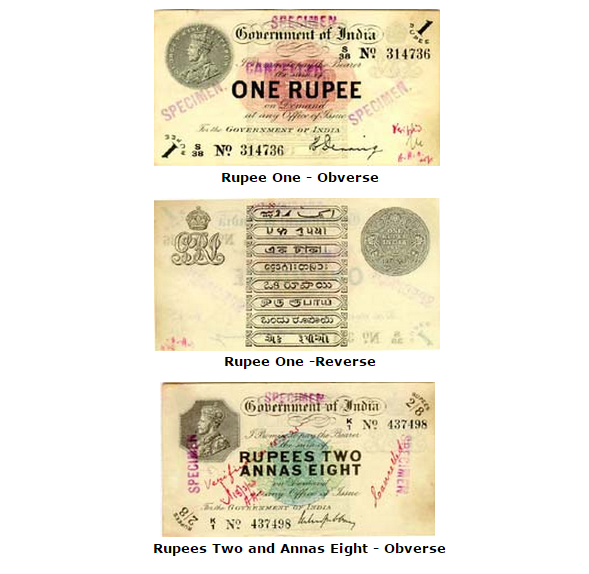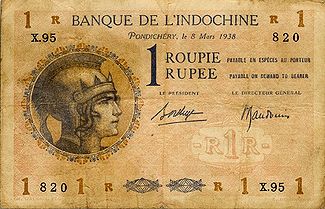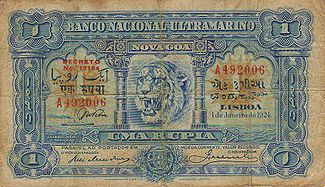Friday, March 6th 2015
With new design on the way, a short photo history of the Rupee One note
The Reserve Bank of India has announced the reintroduction of the phased-out one rupee note. Here is a look at the old ones.

Photo Credit: Wikimedia Commons
One rupee notes, almost completely phased out of Indian wallets, are making a comeback. Twenty years after the Indian government stopped printing Rupee One notes, the Reserve Bank of India announced recently that new ones will now be issued again.
The new notes are set to be predominantly pink and green on both sides, in combination with other colours. An image of the oil exploration rig of Sagar Samrat off the Mumbai coast will feature on the reverse, much like the older notes of the 1980s and '90s.
Printing and circulation of Rupee One notes were stopped in 1994, when the government made a complete switch to coins of that denomination. Unlike notes of other denominations, which are printed by the RBI, one rupee notes were always printed directly by the central government, along with rupee coins, under the Coinage Act.
The new notes will also be printed by the central government, to serve as legal tender along with the older one rupee notes.
As collectors and currency enthusiasts prepare to add a brand new note to their archives, here is a walk through the history of Rupee One notes in India.
Before 1947
The introduction of small denomination notes in India was connected directly with war-time adversities. The very first Rupee One note was printed on November 30, 1917, during World War I, with a portrait of King George V on the front and the words "one rupee" on the reverse in eight regional languages.

Photo: rbi.org.in
According to Bangalore-based blogger and currency enthusiast Rezwan Razack, 25% of these Rupee One notes were issued in small booklets of 25 notes each.
This note was followed soon after by the note of Rupees Two and Annas Eight, but both were discontinued by 1926.
Rupee One and Rupee Two notes were reintroduced during the second World War. Although many of them were dated 1935, they were issued in August 1940. This time, Rupee One notes carried a portrait of King George VI.

Photo: Wikimedia Commons.
The British, however, were not the only rulers to issue currencies in India – notes and coins were issued separately by the princely state of Hyderabad, the Bank of Indochina in France (for French colonies) and the Portuguese government in its colonies.


The French Indian Rupee and the Portuguese Indian Rupia. Photos: Wikimedia Commons
After 1947
During British rule, one rupee comprised 16 annas, but with independence came a new system of division, where each rupee was equal to 100 naye paise, or new paise.
A new design was introduced in 1949, devoid of the symbols of the British colonisers. According to the RBI website, the government first considered a portrait of Mohandas Gandhi to replace King George, but it finally settled on a picture of the Lion Capital of Ashoka – which was subsequently made the official emblem of India in 1950.


Rupee One, 1949, obverse and reverse. Photos: indiabanknotes.com
In 1969, issued the only Rupee One note featuring Gandhi, in a commemorative issue celebrating his birth centenary.

Photo: indiabanknotes.com
Then in 1981, a new design featured an image of India’s oil exploration rig Sagar Samrat, which is set to be retained in the new pink and green Rupee One notes the RBI wants to re-introduce.

Photo: indiabanknotes.com
We welcome your comments at letters@scroll.in.
Share this:
Trending on Scroll
It is only Thursday and India has already imposed six bans this week
Scroll Staff
· Yesterday · 06:06 pm
Film review: Hindi indie Coffee Bloom lacks kick
Nandini Ramnath
· Today · 08:00 am
Rape, rape culture and the debate over India's Daughter
Kavita Krishnan
· Mar 4, 2015 · 06:53 pm
Photos from the British report on hemp that saved Holi thandais from a ban in 19th century India
In the world's most thorough report on cannabis, the British government decided instead to tax it more.

Photo Credit: Report of the Indian Hemp Drugs Commission, 1894.
It is that time of year again when it becomes socially acceptable to consume large quantities of drugs with only moderate fear of police harassment. Bhang, the key ingredient of thandai consumed around the time of Holi, needs only a permit to be consumed and is not banned outright.
The control of bhang and other hemp-related intoxicants is recent, dating only to the Narcotics and Psychotropic Substances Act of 1985, which itself followed a United States-led campaign against drug.
Ninety years before India banned most hemp products, the British government in India produced the world’s most comprehensive reflection on the effects of cannabis use that concluded it was not worth banning.
The remarkable seven-volume report that the Indian Hemp Commission submitted to the British Parliament in 1894 was the result of a concerted temperance campaign in the United Kingdom. Mark Stewart, a British Member of Parliament and noted temperance activist, following a report in the Allahabad Times in 1892 that most inhabitants of lunatic asylums in India were ganja consumers. Given that the government was charging excise on ganja, he wanted to know if the substance was indeed worth banning entirely in the state of Bengal.

A hemp drug shop, bhang, ganja and majum displayed, Khandesh. Report of the Indian Hemp Drugs Commission, 1894.
A Britain that had only a few decades earlier won a second war in China to enforce opium trade in the country was hardly likely to ban a similarly intoxicating though less harmful or prolific product in India, where it had absolute control. In the 20 years from 1873 to 1893, taxes on ganja cultivation had earned the Bengal government alone Rs 1 crore at that rate of exc ...
Share this:
The Daily Fix: India wants the world to block a BBC film everyone's already seen
Everything you need to know for the day (and a little more).

Photo Credit: BBC
Above the Fold: Top stories of the day.1. Happy Holi! The festival of colour is one of those special Indian events that sees national newspapers giving you recipes for cannabis drinks.
2. India plays West Indies in its fourth match of the cricket World Cup.
3. A sudden jump in trade between UAE and India has intelligence agencies concerned it might be the sign of money laundering.
4. Sri Lanka has decided to suspend a port-city project that was set to be built by a Chinese firm, a decision that will bring some cheer to India as Prime Minister Narendra Modi prepares to go to Colombo next week.
The Big Story: Ban-ana RepublicThe Indian government has sent a legal notice to the BBC for airing a documentary featuring interviews with one of the perpetrators of the December 2012 gang-rape-murder. The government had promised to ensure the movie is not seen, but the British public broadcaster went ahead and aired it internationally on Wednesday. Indian authorities have also filed a criminal case against the people behind the documentary.
In addition, the government attempted to prevent the movie being seen in India, asking YouTube to take down all versions from its servers. As Finance Minister Arun Jaitley himself acknowledged earlier this year, however, it's impossible to take things down from the internet. The movie ended up proliferating across video sites and most likely was seen by many more people as a result of the ban. The government, however, remains adamant and has been telling reporters that the documentary filmmaker misled authorities about her intentions, although no proof of this has been ...
Share this:
Nagaland mob drags alleged rapist out of jail, lynches him in town centre
Major developments from around the country.

Photo Credit: ndtv.com
Nagaland: Mob justice for alleged rapist
An alleged rapist was dragged out of jail and lynched by a mob in the town of Dimapur on Thursday. Syed Farid Khan was said to be a Bangladeshi businessman who had allegedly sexually assaulted a girl in the town on February 23. “The security personnel manning the jail watched helplessly as the mob shattered two gates and took the accused out”, said a senior police official. The town’s deputy commissioner Wezope Kenye said that tensions had risen high in the town following the incident. At least 20 shops were vandalised.
Delhi: Mayank Gandhi reveals details of AAP meetAam Aadmi Party leader Mayank Gandhi on Thursday criticised the party for removing Yogendra Yadav and Prashant Bhushan from its Political Affairs Committee on Wednesday. Gandhi said that party leader Arvind Kejriwal had expressed his unwillingness to work as AAP's national convener if Yadav and Bhushan continued to be part of its PAC. “I was taken aback by the resolution to remove them publicly, especially as they themselves were willing to leave”, said Gandhi. Yadav, according to Gandhi, had suggested the reconstitution of the PAC through voting as a compromise, and had said that he and Bhushan would not put forward their candidature for it. Gandhi abstained from voting on the proposal to remove the two.
Maharashtra: Government removes reservations for Muslims in education
The Devendra Fadnavis-led government in Maharashtra
Share this:
Five things Arvind Kejriwal has to fix immediately if he doesn't want to turn into a Modi-like autocrat
How is this different from Modi kicking out Sanjay Joshi?

Photo Credit: PIB
The comparison would sound jarring to some but it also happens to be somewhat appropriate. An immensely popular party leader refuses to turn up to a national body meeting, insisting that dissenting voices should be kicked out of the committee. The party leadership follows suit and dissenters are kicked out. In one corner, you have Prime Minister Narendra Modi and fellow Bharatiya Janata Party leader Sanjay Joshi. In another, Delhi chief minister Arvind Kejriwal and senior Aam Aadmi Party leaders Yogendra Yadav and Prashant Bhushan.
In both cases, the leaders used their political capital to prevail. Modi, then chief minister of Gujarat, refused to even attend the BJP's parliamentary board meeting in 2012 unless Joshi, with whom he had feuded before, was booted from the panel. Despite unhappiness from other senior leaders, Joshi had to resign. On Wednesday in Delhi, the same story played out as Yadav and Bhushan were taken off AAP's political affairs committee, its top decision-making body, with vague assurances that they will be given other roles.
A gag order was then placed on everyone at the national executive meeting, with no member allowed to talk about what happened inside, although it was apparent from early on that the decisions made were hardly unanimous. Delhi Chief Minister Arvind Kejriwal conveniently stayed away from the meeting itself and jetted off to Bangalore soon after to undergo treatment for his ill health, but the impression created and since confirmed was that he has prevailed. He wanted Yadav and Bhushan out of the PAC and that's what he's gotten.
This has prompted channels to dub AAP the "Arvind Alone Party" suggesting that Kejriwal has turned into an autocrat and, like every other political outfit in India, is silencing dissent and doing as he wishes. If he wants ...
Share this:
Government sends legal notice to BBC about rape documentary broadcast
Today's major developments.

Photo Credit: Toby Melville/Reuters
India trying to muzzle free speech, says documentary filmmaker
The Union government on Thursday sent a legal notice to the British Broadcasting Corporation about the telecast of a documentary dealing with the December 2012 gang-rape and murder of a young woman in Delhi. The notice was issued by Alok Verma, the director of the Tihar jail in New Delhi. The government also moved to have the documentary removed from YouTube. Union Home Minister Rajnath Singh said that appropriate action would be taken if the broadcaster was found to have violated the conditions of its agreement with the jail. Meanwhile, Leslee Udwin, the director of the documentary, accused the Indian government of trying to “muzzle free speech”. Udwin had earlier called on Prime Minister Narendra Modi to “deal with the unceremonious silencing of the film”.
Modi to offer military and civilian assistance to island neighbours
Prime Minister Narendra Modi is expected to offer military and civilian assistance to India’s island neighbours such as Sri Lanka, the Maldives and Mauritius. Modi, in his visit to Sri Lanka next week, will make a push for extended security cooperation with the countries by offering patrol ships, surveillance radars and ocean mapping technology. This is an attempt to take back some of the influence gained by China in the region, which has spent billions of dollars on projects with these countr ...
Share this:
These miniature paintings show how the Mughals and other Indians royals celebrated Holi
Everyone from the Mughals to the
lesser kings of Nagaur and Golconda seemed to want to look their best
for the festival of colours.

Photo Credit: Maharana Swarup Singh of Mewar, 1851
Your Holi celebration this year is not likely to be as lavish as that of the Mughals. Three hundred years ago, the emperors, otherwise relatively pious Muslims, celebrated the festival with great enthusiasm.
The Mughals developed a remarkably syncretic culture. Akbar commissioned exquisite Persian manuscripts of the Ramayana and Mahabharata. Jehangir and Shah Jahan commissioned paintings of themselves with Jesus Christ and Mary. In these paintings, they are seen celebrating the festival of colour.
But it was not just the Mughals. In many parts of India, kings commissioned paintings of them and their harems throwing coloured powder at each other in decadent fashion. One magnificent painting from Nagaur around 1750 even shows the Maharaja of the place flinging colours with half-dressed women in a pond.
Here are some of the celebrations you are not likely to match.

Jehangir celebrates the Hindu festival of Holi, unknown artist, c 1635. Photo credit: Wikimedia Commons.

The Mughal Emperor Muhammad Shah celebrating Holi, by Bhupal Singh c 1737. Photo credit: Asia Society.

The Holi festival, by Mir Kalan, 1734-1735. Photo credit: Wikimedia Commons.

Maharaja Bakhat Singh rejoices during Holi, Nagaur, c 1748-50. Photo credit: Mehrangarh Museum Trust. ...
Share this:
No comments:
Post a Comment